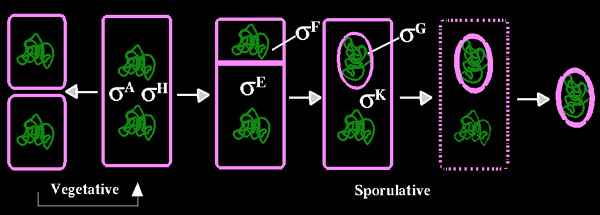Introduction
to DevelopmentMolecular
Microbiology Department, John Innes Centre
Single-cell Differentiation: Stalk and Swarmer
Single-cell Differentiation: Endospore Formation
Differentiated Cells
Cooperate: Cyanobacterial Heterocysts
Multicellular Differentiation: Streptomycetes
Multi-species
Development: Biofilms (Kolter Laboratory)
Introduction to Development
What is meant
by development?
In complex multicellular organisms, development is
understood as the process by which a single fertilized egg transforms
itself into a multicellular organism with differentiated tissues and
organs. Development is marked by these features:
- Cells of the developing organism maintain the same DNA
content as the original cell. That is why it's possible to clone a mammal
using a somatic cell nucleus. The major exception to this rule is
the immune system, in
which DNA is rearranged in separate clones.
- As cells reproduce, they change into different kinds
of cells with different complementary functions. This process of
change is called differentiation. Most cells (somatic cells) lose
the ability to reproduce themselves directly; instead they depend upon germ cells (such
as sperm or egg) to reproduce, with identical copies of their DNA.
- Differentiation occurs by distinctive regulation of gene expression, in
which different genes and splicing patterns are turned on in different
cell types.
- The differentiated cells form tissues and organs with
different functions that cooperate with each other for the good of the
overall organism. Some lineages of cells are even programmed to
die, to enable maturation of organs; this programmed cell death is
called apoptosis.
In the evolutionary context, however, multicellular
development forms a continuum with developmental processes in
microbes--many of which have major significance for the environment and
for human health. Understanding these forms of microbial
development can enable a deeper understanding of the more complex
systems such as vertebrate animals and vascular plants.
Differentiation of a Single Cell:
Stalk and Swarmer. Top
An example of a single-celled bacterium that undergoes
cellular differentiation is Caulobacter crescentus.
Caulobacter is commonly found swimming in swamps and sewage outlets.
- Caulobacter differentiates into two cell types--but
they do not stay together to cooperate.
A motile swarmer cell of Caulobacter
finds a nutrient-rich place to attach and grow. It loses its flagellum,
replacing it with a stalk that attaches to detritus in the pond.
The stalk cell then divides, forming two
daughter cells: a swarmer (flagellated) and a cell with the original
stalk. The swarmer cell swims off to find a new location,
avoiding competition with the stalk cell left behind.
How does the original cell regulate its
division to produce two different types of daughter cell?
Regulation involves a complex cascade
of cell cycle regulators, including activator proteins and
proteases that cleave the activators.
Differentiation
of a Single Cell: Endospore Formation. Top
Some bacteria can form
long-lived dormant forms called endospores.
Examples include Bacillus
anthracis (cause of anthrax), Bacillus
thuringensis (inch-worm insecticide) and Clostridium
botulinum (cause of botulism; source of Botox protein).
Endospores can remain viable for thousands of years.
- Bacillus
differentiates into two cell types--one of which remains viable to
reproduce, while the other supports its development, then dies.
This behavior is analogous to apoptosis, the developmentally programmed
death of helper cells--a common occurrence during vertebrate
development.
To form an endospore
requires a complex process called sporulation.

Bacteriology
at U.W. Madison

Step-through
sporulation (Doc Kaiser's Page)
The process of sporulation involves:
- Replication of the bacterial chromosome
into two daughter chromosomes.
- Two sigma factors, sigma A and sigma H,
regulate gene transcription to initiate two different developmental
programs in the two daughter chromosomes.
- Compartmentalization of the cell into the
forespore (regulated by sigma F) and the motherspore (regulated
by sigma E).
- The motherspore
assists maturation of the endospore (regulated by sigma G and sigma K),
but its own DNA ultimately disintegrates.

Multicellular
Differentiation: Streptomyces. Top
Streptomyces species
are soil bacteria that produce many kinds of antibiotics, such as
streptomycin. Streptomyces form mycelial structures that
produce spores, in a life cycle remarkably analogous to that of
fungi.
- Streptomyces differentiates into
several cell types within a colony. The cells cooperate to form mycelia, which generate spores that can
start new colonies. This life cycle is analogous to that of
eukaryotic fungi; that is, it is functionally similar, but evolved
independently.
Genome
of Streptomyces coelicolor
|


